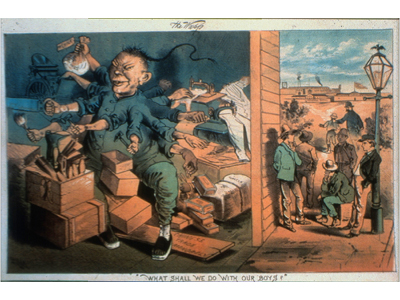

 Though Sacramento's
Chinatown was frequented by many who lived outside of Chinatown,
the area's main function was to provide supplies and services
to the early Chinese settlers. Stores, restaurants, laundries,
and social halls abounded.
Though Sacramento's
Chinatown was frequented by many who lived outside of Chinatown,
the area's main function was to provide supplies and services
to the early Chinese settlers. Stores, restaurants, laundries,
and social halls abounded.
But by the mid 1800's, a seething anti-Chinese sentiment among the working classes was developing. Chinese immigrants became scapegoats for economic hardships because of their race and culture, willingness to work for lower wages and unwillingness to unionize with non-Chinese. Anti-Chinese agitation eventually convinced Congress to pass a national Chinese Exclusion Act in 1882. This law excluded Chinese from entering the United States until its repeal in 1943. Furthermore, the Chinese immigrants, 90% men, were declared ineligible for citizenship or to marry outside their race.
 Following the passage of this act, many incidents of deadly
violence and ethnic cleansing occurred against the Chinese. This
period of American history is now known as "The Driving Out"
with forced removals of the Chinese from Cherry Creek, Colorado;
Tacoma, Washington; Tombstone, Arizona; Rock Spring, Wyoming;
and Redlands, and California. A popular saying came into the American lexicon
"He doesn't stand a Chinaman's chance."
1
Following the passage of this act, many incidents of deadly
violence and ethnic cleansing occurred against the Chinese. This
period of American history is now known as "The Driving Out"
with forced removals of the Chinese from Cherry Creek, Colorado;
Tacoma, Washington; Tombstone, Arizona; Rock Spring, Wyoming;
and Redlands, and California. A popular saying came into the American lexicon
"He doesn't stand a Chinaman's chance."
1
Sacramento's Chinatown was no different than the rest of America. But the resilient nature of Chinese businessmen and their tenacious attitude towards the hostility of white society was best tested after the "Driving Out." Mysterious fires were rampant in America's Chinatowns and Sacramento was no exception. Although untouched by the first major fire which swept through Sacramento in 1852. The second fire of similar intensity on July 1854 destroyed the greater part of the downtown blocks on both the north and south side of I Street from Third to Seventh Streets. Many canvas structures and wood shanty-like buildings quickly fell victim to the racing flames. Many Chinese lives were lost and their belongs scattered.
Records of business permits indicate that within the first four months after that particular fire the Chinese business houses literally sprung back, eleven business licenses were issued to the Chinese on Street, these included five markets, one merchandising store, a bar and boardinghouse, and three gambling houses. 2
Twelve months later on July 1855 another major fire struck Chinatown and roared through the area so rapidly it consumed an entire half block in half an hour. The fire was reported to have started in the second floor of the Sze Yup building. This time the Sacramento Fire Department allowed for the fire to burn as long as the wind was shifting northward towards the slough and away from the rest of the town. The loss was estimated at $65,000 to $100,000. Suspicious of the city's intentions, the Chinese took their injured to the Sze Yup Association's charity house for safety and medical care instead of the city's hospitals. 3
In a final effort to "drive out" the Chinese, the Board of Trustees, forerunner to the City Council, amended an ordinance to require only fireproof buildings be erected in the burnt out section of Chinatown. This would require brick, one the most expensive building material of the day. Many city leaders felt the Chinese could not afford to build with brick. But seeing the wisdom of this ordinance the members of the Sze Yup Association immediately complied and rebuilt their building with bricks as did other Chinese merchants. 4
The newspapers of the of the time contributed greatly to mass racism and anti-Chinese sentiment in California. The Sacramento Union claimed as early as November 1852 the Chinese converted Sutter Lake, a great pond, into a perfect washtub and lined its margins completely around with dripping linen's. Besides using the lake for their washing the newspaper rumored that the Chinese living in buildings on the north side of I Street were dropping their debris and filth directly into the lake and letting the tide remove the waste. The prolonged and systematic anti-Chinese accusations created mass resentment within the city. 5
By 1909, with the Chinese driven out of China Slough, there was a concerted effort by city officials and the Southern Pacific Railroad to fill China Slough, burying Chinatown under rock and rubble. This is where the railyards exist today.
1. www.apa.si.edu/ongoldmountain. Chinese were forced out of Humboldt and Fresno counties, and nurseries and vineyards around Fresno. In the 1880s there was a 37 percent decline in California’s Chinese population. During this period the saying, “He doesn’t stand a Chinaman’s chance,” came into the American lexicon.
2. Praetzellis, IJ56, p. 16
3. Praetzellis, IJ56, pp. 16-7.
4. Praetzellis, IJ56, p. 28.
5. Alexander Saxton, The Indispensable Enemy: Labor and the Anti-Chinese Movement in California